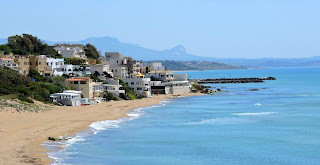 |
| classic Greek temple, Selinunte |
 |
| grain-measuring holes in limestone |
There are many grape varietals grown on all over the island, from the volcanic soils of Mt. Etna to the limestone areas of the west and southwest. We visited one of the premier wineries today, Planeta Ulmo. The Planeta family is now in its 17th generation of farmers, with 6 wineries and 3000 acres of vineyards spread across Sicily in order to take advantage of the different growing conditions. They sell most of their wines to the United States.
We toured and tasted with one of the current generation of family members who now run the vineyards and wineries. There are 15 children in her generation, 7 of whom run the various businesses. Their family originally came to Sicily from Spain. They are very proud of their wines and invest heavily in research and new varietals in order to produce exceptional wines.
 |
| wine tasting at Planeta Ulmo winery |
Sicily's limestone is also the material of its gorgeous temples, mostly from the Greek era, built between about 650 BC and 350 BC. You'd think you might get tired of touring temples, but we have loved every site since each one has a different history and incredible views.
 |
| village below Selinunte |
Today, we visited Selinunte, perched above the deep blue Mediterranean. Earthquakes and Carthaginians were the ruin of these temples. Only one has been partially rebuilt, while others lie in collapsed grandeur across several kilometers of tableland high above the sea.
 |
| Greek bathtub |
When first excavated, the entire area was covered with dirt, so the archaeologists had no idea what they would find. Digging down 15 feet, they discovered 3 huge temples in one area and 3 more across a river on what was once the Selinunte Acropolis. Fortunately, the columns of one of the temples had collapsed in place, so the temple could be rebuilt just as it was. The other temples look as if the huge stones had been tossed about randomly, piled in enormous jumples of rock.
 |
| huge capital, upended, from top of Doric column |
 |
| Acropolis with wildflowers |
On the nearby Acropolis, archaeologists reconstructed only one side of one of the temples, but were also able to unearth the large market area surrounding the temple and the central road that crossed the Acropolis from the mountains to the sea. This area has dozens of small two-room shops which probably also had a second floor where the proprietor may have slept. The housing area was separate, as the Greeks never lived among their temples, and has not been excavated.
Tonight we arrived at Agrigento, where the Valley of Temples has 2 reconstructed Greek temples and lots of huge carved limestone pillars and blocks--former temples, markets, villas and houses. We crossed low, but rugged limestone mountains, with several large quarries still operating, as well as hillsides covered with vineyards, olive trees and wildflowers. We are fortunate to be in Sicily at the peak of the wildflowers so are enjoying hedgerows of brilliant yellow daisies, purple clover, bright red poppies and flowering thistles of many colors.

No comments:
Post a Comment